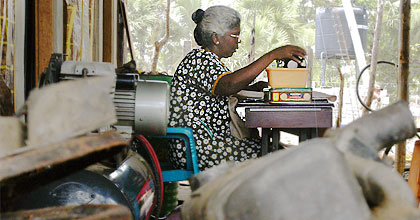
Thanks to a micro-credit loan obtained from an informal women's union,
Devagi is able to resume her sewing livelihood.-Keith Lin
Banking on rural microfinance
KEITH LIN
KALMUNAI, SRI LANKA
Inside a dusty garage strewn with broken pushbikes, steely-looking seamstress Devagi stitches a colourful sari on a gleaming new "Singer", oblivious to the incessant hammering of metal pistons.
Having successfully obtained a micro-credit loan of 30,000 Sri Lankan rupees (300 US dollars) following last December's Boxing Day tsunami disaster, not even the ear-piercing din at her makeshift workplace can distract Devagi from her handiwork.
"I used most of the money to buy the sewing machine, some sewing materials and a pair of spectacles, which I can't see anything without," says Devagi, who lost her husband, a worker at the neighbouring rice mill, to towering 15-foot waves.
Every month, Devagi, who like many of her countrymen go by a single name, repays around half of her income, or 2,000 rupees, to the Sri Lanka Women's Development Services Cooperative Society, an informal women's union based in Colombo.
The loan is interest-free, she says. If business is poor, the 42-year-old mother of two, who lives in a threadbare canvass tent a year after the tsunami struck her remote coastal village, can tap into a 10,000-rupee fund her union helps to safe-keep.
"My children wanted to help me (with the money), but they're married and have their own problems. I'm really grateful for this loan," says the Tamil-speaking lady, her voice cracking.
Micro-credit has given women like Devagi a rare glimpse of normality in this impoverished eastern province. In an area ravaged by decades of ethnic conflict, the tsunami killed about 31,000 and left more than a million homeless.
These schemes are largely provided by "seethus", or ragtag cooperative unions and are not new. "Seethus" have long been extending small loans for entrepreneurial projects in the forgotten backwaters of Sri Lanka. Recipients are usually so poor that they do not qualify for normal bank loans.
Now, the island's high unemployment rate has thrown such schemes into the spotlight. The International Labour Organisation estimates unemployment to have risen to more than 20 percent from 9.2 percent before the tsunami.
next »